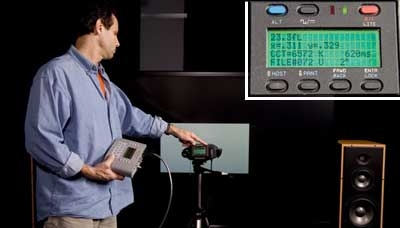Picture Perfect: TV Calibration Demystified Page 3
|
|
| A colorimeter is used to do grayscale calibration. The colorimeter's readout shows 6,572 K - very close to the 6,500 K standard for white. |
Shades of Gray The calibrator will bring up a window pattern with a gray rectangle centered on a black background. Most TVs only have two adjustments for color temperature: one for the low-IRE window (similar to a "brightness," or black-level, control) and one for the high-IRE window (similar to a "contrast," or white-level, control). While taking readings from his test equipment, the calibrator will change the red, green, and blue levels. He'll go back and forth between low and high windows until both measure as close to D65 as the set allows.
A calibrator working with an optical comparator can use only the high and low windows to make adjustments. Although someone who's good at using a comparator can do a decent job this way, his decisions are still subjective. Using a color analyzer, on the other hand, allows for more flexible adjustments and provides an exact reading. Analyzers are also better than comparators because they let the calibrator take readings all along the grayscale, not just the low and high windows.
Most analyzers are attached to the TV screen using a suction cup. They provide color-temperature readings in kelvins (K) and light-output readings in foot-lamberts (ftL) and also give the temperature's precise points on the CIE chart.
The calibrator next makes sure the color, tint, brightness, and contrast are okay - and that's it. Smile - you've just been ISF'd!





























































